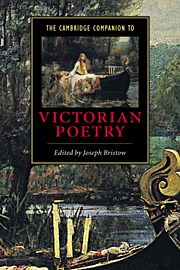Book contents
- Frontmatter
- 1 Reforming Victorian poetry: poetics after 1832
- 2 “The Lady of Shalott” and the critical fortunes of Victorian Poetry
- 3 Experimental form in Victorian poetry
- 4 The dramatic monologue
- 5 Victorian meters
- 6 Victorian poetry and historicism
- 7 Victorian poetry and science
- 8 Victorian poetry and religious diversity
- 9 The Victorian poetess
- 10 The poetry of Victorian masculinities
- 11 Aesthetic and Decadent poetry
- 12 Victorian poetry and patriotism
- 13 Voices of authority, voices of subversion: poetry in the late nineteenth century
- Glossary
- Guide to Further Reading
- Index
9 - The Victorian poetess
Published online by Cambridge University Press: 28 May 2006
- Frontmatter
- 1 Reforming Victorian poetry: poetics after 1832
- 2 “The Lady of Shalott” and the critical fortunes of Victorian Poetry
- 3 Experimental form in Victorian poetry
- 4 The dramatic monologue
- 5 Victorian meters
- 6 Victorian poetry and historicism
- 7 Victorian poetry and science
- 8 Victorian poetry and religious diversity
- 9 The Victorian poetess
- 10 The poetry of Victorian masculinities
- 11 Aesthetic and Decadent poetry
- 12 Victorian poetry and patriotism
- 13 Voices of authority, voices of subversion: poetry in the late nineteenth century
- Glossary
- Guide to Further Reading
- Index
Summary
Thou hast given
Thyself to Time and to the world. Thy strains
In many a distant day, and many a clime,
Shall be thy living voice - nay, not that voice;
But the soul's voice, the breathing poetess.
- [Anonymous,] “To a Poetess” (1856)This tribute “To a Poetess” may seem a perverse note on which to begin this chapter, not least because the poem was most probably written by a member of the Langham Place group: the first identifiably feminist organization to promote women's rights in England. Why would a feminist writer praise the figure of the poetess? After all, the very word poetess has for most of the twentieth century sounded unequivocally patronizing. As the feminized form of poet (a word that can sound gender-neutral), poetess suggests not the difference in degree implied by a modifier like “woman” but the absolute difference in kind implied by separate nouns. Despite the negative connotations that the term eventually acquired, it is worth remembering that it would be hard for Victorians to grasp the extent to which “poetess” sounds unnecessarily gendered to us. As Isobel Armstrong asserts: “It is probably no exaggeration to say that an account of women's writing as occupying a particular sphere of influence, and as working inside defined moral and religious conventions, helped to make women's poetry and the 'poetess' . . . respected in the nineteenth century as they never have been since.”
- Type
- Chapter
- Information
- The Cambridge Companion to Victorian Poetry , pp. 180 - 202Publisher: Cambridge University PressPrint publication year: 2000
- 16
- Cited by

